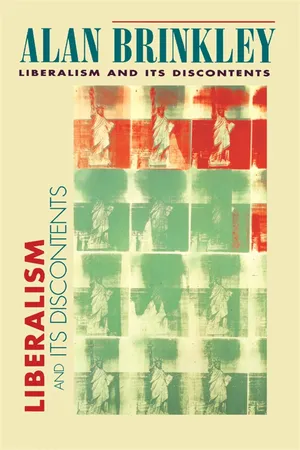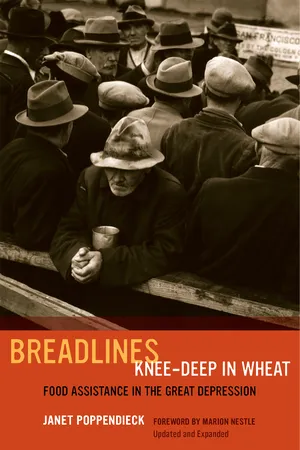History
Legacy of the New Deal
The legacy of the New Deal refers to the lasting impact of the comprehensive set of economic and social programs implemented by President Franklin D. Roosevelt in response to the Great Depression. The New Deal's legacy includes the establishment of Social Security, labor rights protections, and infrastructure development, shaping the role of the federal government in addressing economic challenges and promoting social welfare.
Written by Perlego with AI-assistance
Related key terms
1 of 5
4 Key excerpts on "Legacy of the New Deal"
- eBook - PDF
- Alan Brinkley(Author)
- 2000(Publication Date)
- Harvard University Press(Publisher)
But most of its limited discussion of domestic issues centered on how the New Deal had “found the road to prosperity” through aggressive compensatory meas-ures: ªscal policies and social welfare innovations. 60 The changing landscape of liberalism was visible as well in some of the ªrst retrospective celebrations of the New Deal, in the way early defenders of its legacy attempted to deªne its accomplishments. In 1948, Arthur M. Schlesinger, Jr., published an essay entitled “The Broad Accomplishments of the New Deal.” The New Deal, he admit-ted, “made no fundamental attempt to grapple with the problem of the economies of concentration or of the decline in outlets for real invest-ment.” But that, he claimed, was not really the point. The New Deal’s most signiªcant accomplishments were much simpler and more impor-tant: “The New Deal took a broken and despairing land and gave it new conªdence in itself. . . . All [Roosevelt’s] solutions were incomplete. But then all great problems are insoluble.” 61 The importance of the New Deal lies in large part, of course, in its actual legislative and institutional achievements. But it lies as well in its ideological impact on subsequent generations of liberals and in its ef-Th e Late New Deal and the Idea of the State 61 fects on two decades of postwar government activism. And in that light, the New Deal appears not just as a bright moment in which reform energies brieºy prevailed but as part of a long process of ideological adaptation. For more than half a century Americans concerned about the impact of industrialization on their society—about the economic instability, the social dislocations, the manifest injustices—had harbored deep and con-tinuing doubts about the institutions of capitalism. Few had wanted to destroy those institutions, but many had wanted to use the powers of government to reshape or at least to tame them. - Available until 27 Jan |Learn more
The Achievement of American Liberalism
The New Deal and Its Legacies
- William H. Chafe, William Chafe(Authors)
- 2002(Publication Date)
- Columbia University Press(Publisher)
The New Deal launched other programs as well, offering financial assis-tance to imperiled homeowners, farmers, and small businesses. Even taken to-gether, these early relief programs were modest when measured against the gravity of the problems they were trying to address. For the people they helped, they were a godsend. For millions of others, they were simply an al-luring but unattainable promise. These early experiments in providing relief revealed both the extent and the limits of the New Deal commitment to social welfare. Roosevelt and those around him clearly rejected the rigid conservative views of those who considered any aid to the poor dangerous and improper. In 1931, as gover-nor of New York, Roosevelt had challenged that orthodoxy. Government had a clear responsibility, he told the state legislature, “when widespread eco-nomic conditions render large numbers of men and women incapable of supporting either themselves or their families because of circumstances be-yond their control which make it impossible for them to find remunerative labor. To these unfortunate citizens aid must be extended by government— not as a matter of charity but as a matter of social duty.” 4 As president, he continued to reject the conservative argument against social assistance. But Roosevelt, Hopkins, and most of the other critical figures in shaping the New Deal welfare state also feared the debilitating effects of what was still widely known as “the dole.” Harry Hopkins, looking at the effects of the FERA in 1933, said, “I don’t think anybody can go on year after year, month after month accepting relief without affecting his character in some way un-favorably. It is probably going to undermine the independence of hundreds of thousands of families . - eBook - PDF
Breadlines Knee-Deep in Wheat
Food Assistance in the Great Depression
- Janet Poppendieck(Author)
- 2014(Publication Date)
- University of California Press(Publisher)
CHAPTER TWELVE Food Assistance: The Legacy of New Deal Policy Choices n June 1937, the Roosevelt administration, once again flirting with the seductive notions of a balanced budget and a restoration of business confidence, dramatically cut spending and sharply re-duced the WPA rolls. As summer gave way to autumn, the stock market fell off precipitously, and the layoffs began, initiating an economic nightmare variously called a recession or a depression, depending upon how closely one was associated with the administration. By March 1938, 4 million people had been thrown out of work. 1 Predictably, the cities and states, which had only grudgingly shoul-dered responsibility for relief of the unemployables, were unprepared for the large number of families rendered destitute by each new round of layoffs, and the WPA had nowhere near enough slots to go around. In an accelerated version of the aftermath of 1929, local relief agencies ex-hausted their resources, and cities exhausted their statutory borrowing limits. In the Midwest, where the steel and auto industries were espe-cially hard hit, stark destitution was obvious by Christmas. In Cleveland, relief stopped altogether for the first six days of the New Year, and the behavioral indices of hunger— scavenging and begging—were once again reported. 2 In January, a special census of unemployment shocked the administra-tion with the news that between 7.5 and 10 million people were out of work and the prediction that more people would soon be unemployed than had been when Roosevelt was elected in 1932. Comparisons with that dreadful year began to appear with great frequency, and nowhere were the I The Legacy of New Deal Policy Choices 235 similarities more marked than in relief activities. Relief needs are ap-proaching those of the darkest days of 1933, and in some areas such as Cleveland and Detroit, may actually be greater, reported The Nation. - eBook - PDF
New Democracy
The Creation of the Modern American State
- William J. Novak(Author)
- 2022(Publication Date)
- Harvard University Press(Publisher)
All “in the shadow of Roosevelt” is how a leading history summed up American presidential administrations from Truman to Obama. 2 That long shadow continued to cloud the return of progressive politics in 2020 as calls for a more radical policy agenda were readily dubbed a “Green New Deal.” N E W D E M O C R A C Y 260 Such is the power of the New Deal to capture and circumscribe the imagi- nation of the American democratic political. And such is the tenacity of the myth of the New Deal state. A central premise of the myth of the New Deal state is the idea that the creation of a distinctly modern state and a refurbished social democracy in American history awaited the historic events of the mid-twentieth century: depression, executive reorganization, and world war. Before FDR, before the New Deal revolution, conventional wisdom too frequently suggests, American politics and policy making were trapped beneath the weight of the anachronistic inheritances of small government, classical political economy, and constitutional limitations. The central myths challenged by this book—of a weak state, laissez-faire, and Lochnerism—thus very much burnished the image of the New Deal as the crucial turning point, a new beginning, in the construction of the modern American state. Like most myths, the one about the New Deal state has roots in a rather dramatic and exceptionalist origin story as the New Deal is lifted out of the prosaic stream of American secular history and placed on new, higher ground. Principal actors take on almost mythic proportions, and extraor- dinary causal force is imputed to their quotidian personal interactions.
Index pages curate the most relevant extracts from our library of academic textbooks. They’ve been created using an in-house natural language model (NLM), each adding context and meaning to key research topics.



